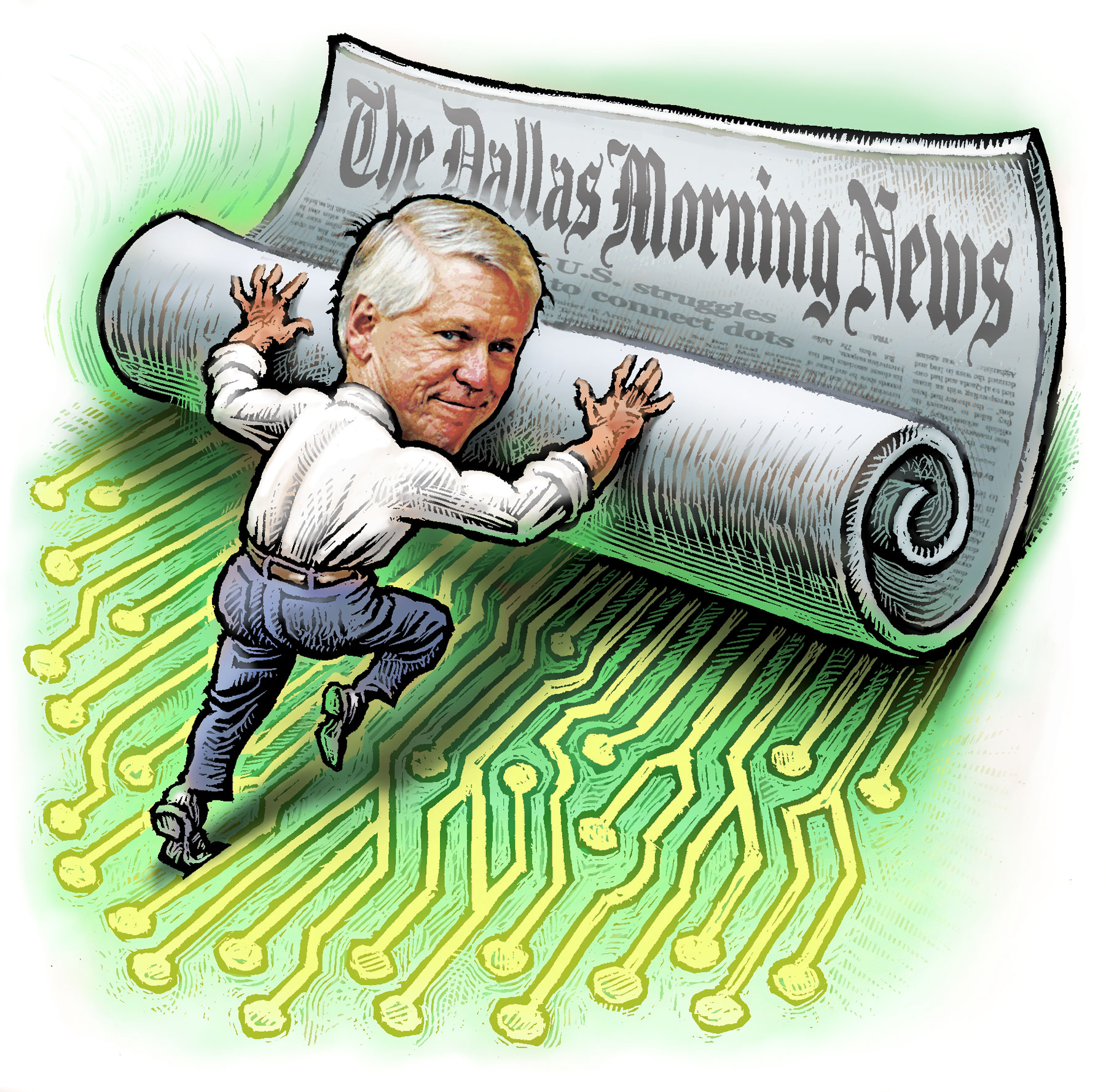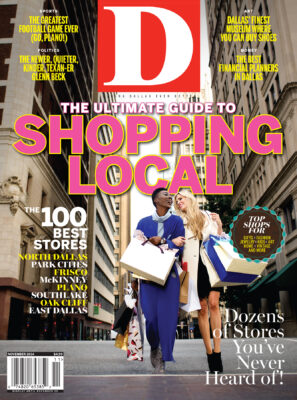Walking through the Dallas Morning News’ fourth-floor executive suite to the publisher’s office feels like a scene out of Mad Men. Secretarial cubes sit in a large, open space outside glass-lined offices that overlook downtown. Jim Moroney himself looks the part, dapper as always in a smart gray suit and crisp white shirt. We sit at his office table, and he produces a tiny digital recorder to ensure that I quote him accurately. Next to it, I plop my brick-size four-track recorder. Game on.
Moroney isn’t being defensive by recording our conversation. He’s being smart. He is, after all, the CEO of a publicly traded company, and I want to talk with him about a decision he’s about to make, hiring the next editor of his newspaper. Bob Mong, the man who came to that position the same year Moroney became publisher, 13 years ago, will retire next year. (As well, the paper’s two-time Pulitzer-winning managing editor, George Rodrigue, decamped for WFAA Channel 8 in September.)
Mong will leave behind a paper that has maintained its prestige and ability to break big stories while weathering an industry-wide decline in revenue and morale-crippling layoffs. The newsroom has shrunk from a high of more than 600 reporters and editors to about 325 today.
Most of what Moroney says isn’t worth quoting. It’s well-rehearsed biz speak he has already offered in any number of earnings conference calls. No matter. I’ll tell you what others say—investors, executives, newsroom staff, former employees—and what I think, as someone who has covered the paper since 1993. Hiring the next editor is a Big Decision for Moroney. “It’s a top-five moment in the history of the paper,” says one of the paper’s top journalists. “It’s more than that,” says a company manager. “It’s everything.”
Will Moroney get this decision right? That’s the big question. His backers say he usually gets the big decisions right. That’s how the company has remained relatively healthy compared to its peers. “Jim made me a ridiculous amount of money by betting on him and his team twice over,” says Brian Ferguson, who, with other investors, bought about 7 percent of A.H. Belo Corp.’s stock in 2009 and who still owns “a material interest” in the company. Ferguson says back then, he thought the paper didn’t make the dramatic changes that were necessary to innovate. “I didn’t agree with everything they did. Yet, the way they did it, versus the way I would have done it, turned out to be better. And I believe that’s not just because he’s a data-driven businessman. It’s also because Jim gives a shit about journalism, and he will do everything he can to maintain quality journalism.”
Here’s the climate in which the News finds itself: in 2004, U.S. newspapers took in $56.5 billion in print advertising revenue. Last year, they took in $17.3 billion, which was down nearly 9 percent from the year before. The News’ advertising woes mirror this trend. In 2006, the paper’s advertising brought in $406 million of a total $498 million in net operating revenue. Last year: $83 million on $276 million total.
Ferguson is bullish on the paper because of what Moroney has done to brace the paper against the beating of those numbers. He divested the company of its superfluous smaller papers on each coast (Riverside, California, and Providence, Rhode Island); in 2012 alone, he created five new revenue streams tied to the paper’s content, including an events company, a digital shop, and a content marketing firm; and he fixed the balance sheet, socking away $100 million in cash and eliminating the paper’s debt. “I look at balance sheets all over the country,” Ferguson says, “and the DMN’s is one of the best.”
But fixing your balance sheet as your core print business dissolves is a little like tending to a car crash victim who also has cancer. Moroney still has to figure out how to replace the money disappearing from print (digital ads won’t do it alone), grow the subsidiary baby businesses he’s attached to the paper, turn his company into a 21st-century news machine—and do that all without undermining the newsroom or betraying the city’s trust in the work it produces.
Those pitfalls are a real concern for the next editor, and they are the source of much of the griping from Moroney’s detractors. As of this writing in early October, rumors of another round of buyouts and/or layoffs were circulating in the newsroom. Moroney seems desperate to avoid more cuts, acknowledging that getting too lean would hinder the newsroom’s ability to be comprehensive in its coverage.
“Our single biggest challenge is that our brand today is still built around a newspaper,” Moroney says. “[Readers] say, ‘The Dallas Morning News is a newspaper.’ We have to change that mindset.” He points out that the print paper reaches about 600,000 people a month, while more than 6 million people visit its website during that time. “If in five years we could do a marketplace survey of everyone under 50, and they … don’t even mention the print edition? If we can accomplish that, we’ve done our job.”
His detractors say Moroney hasn’t proven he can do it. “People who don’t work closely with Moroney like him,” says a reporter. “Those managers who work with him day to day, who’ve seen his temper, they wonder how committed he is to protecting the sanctity of the newsroom. They wonder if the revenue pressures get to him.”
It’s a legitimate concern. Three recent stumbles at the paper suggest that management hasn’t exactly found its stride.
1. The website. First the paper put up a tiered paywall system that made some stories available only to those who paid for access. Then it scrapped that model for a “premium” site for which readers would pay for a cleaner, less ad-cluttered experience. The premium site was roundly mocked. Today everything online is free again. Moroney deserves some credit for pulling the plug quickly when these approaches didn’t work. But I’m told each step was poorly planned.
2. An evening iPad edition. The idea was to give people a nightly quick read that would catch them up on the day’s important Dallas news. A team was formed, and the project got six-plus months into development before dying from mysterious causes, despite being described to me as “a really interesting idea, beautifully executed, something readers would have enjoyed.”
3. The “Best Buy Renovation.” That’s the derisive internal name for the decision to hang televisions throughout the newsroom and in managers’ offices, so that people could keep up with breaking news. In the afternoons, some staffers say, the TVs now just quietly play soap operas and game shows.
A more charitable view of these missteps would see them as simply the cost of trying to solve an impossible print-to-digital puzzle. Moroney says he understands the newsroom’s concerns. He says he’ll hire someone with impeccable journalistic chops who also has “an understanding, an appreciation, a desire, a passion” for the transition to digital. “This person will need grit,” Moroney says. “Change is hard. And some don’t have the grit to stick with change.”
In the end, I believe—maybe it’s hope disguised as belief—that Moroney will get his big decision right. He acknowledges that he has talked to Keven Ann Willey, vice president and editorial page editor, about the job. It’s an inspired thought. Despite deep cultural problems in that department, she has assembled a good team (Rudy Bush, Nicole Stockdale, Mike Hashimoto) and pushed to create her own digital plan rather than wait on the layers of management to deliver one. It would be interesting to see what she would do with the paper.
Before our visit ends, Moroney shows me what he calls the only “business book” he keeps on his desk: the children’s story The Emperor’s New Clothes. It’s his reminder, he says, that he should not listen just to those closest to him, but to everyone around him, lest he look foolish. The best way to cover his butt: find that editor.






